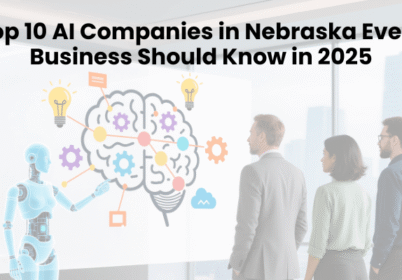Napkin AI Alternatives: Best Tools for Visualization and Collaboration

Table of Contents
The demand for AI productivity and idea-generation tools continues to grow exponentially across professional and creative industries worldwide. Napkin AI has emerged as a notable player in this expanding market of visual ideation tools that transform concepts into visual representations. Many professionals actively seek Napkin AI alternatives to better match their specific workflows, budget constraints, and unique creative processes. The search for Napkin AI alternatives often stems from needs for specialized features or integration capabilities not available in the original platform.
Teams and individuals exploring Napkin AI alternatives typically look for tools offering enhanced collaboration features or more competitive pricing structures for their organizations. The landscape of AI-powered visualization and ideation tools provides numerous options beyond what Napkin AI currently offers to creative professionals. Each alternative brings unique strengths to address specific use cases across different professional contexts and team configurations.
The market for AI-powered productivity tools has evolved significantly in recent years with remarkable innovations in visual thinking. Creative professionals particularly benefit from these advancements in transforming abstract concepts into visual representations with minimal technical effort. Organizations increasingly rely on these visualization tools to communicate complex ideas effectively across distributed teams working in different locations.
Key Takeaways
- Readers will get clear insights into Napkin AI, its limitations, and the best alternatives available today.
- Understand why professionals and organizations seek Napkin AI alternatives for better customization, collaboration, and affordability.
- Explore seven top alternatives—Miro, Lucidchart, Whimsical, Excalidraw, FigJam, Canva, and Notion AI—with their unique strengths.
- Compare features, pricing, integrations, and collaboration capabilities through the detailed comparison overview provided in the article.
- Identify which tools best fit specific needs—whether for technical diagrams, design workflows, or marketing visuals.
- Learn how to evaluate tools based on team size, workflow requirements, budget constraints, and security needs.
- Recognize the importance of testing free tiers before committing to premium or enterprise subscriptions.
- Prioritize integration capabilities over feature count to ensure smooth adoption within existing organizational workflows.
- Select alternatives that not only replace Napkin AI but also enhance team productivity and reduce unnecessary complexity.
Table of Contents
Napkin AI Overview
Napkin AI functions primarily as an AI-powered visualization tool that transforms text descriptions into editable diagrams and visual concepts. The platform excels at converting rough ideas into polished visual representations without requiring extensive design skills or technical knowledge. Users appreciate Napkin AI for its intuitive interface that minimizes the learning curve typically associated with traditional visualization tools. The tool efficiently generates diagrams, flowcharts, mind maps, and other visual assets from simple text prompts or descriptions.
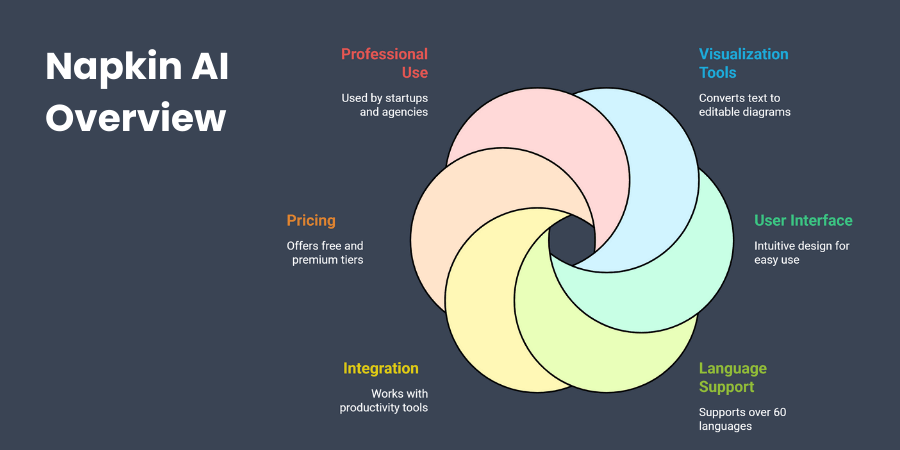
Many professionals utilize Napkin AI during brainstorming sessions to quickly visualize concepts for team discussions and client presentations. The core strength of Napkin AI lies in its ability to interpret natural language and convert it into meaningful visual representations. Its AI engine understands context and relationships between concepts to create logically structured visual representations for better understanding. The platform supports over 60 languages, making it accessible to global teams with diverse linguistic backgrounds and communication needs.
Napkin AI offers integration capabilities with common productivity tools like Slack, Microsoft Teams, and various presentation software packages. The platform provides both free and premium tiers, with advanced features and removal of watermarks available in paid versions. Many startups and creative agencies have adopted Napkin AI to streamline their ideation processes and enhance client presentations effectively.
Product managers frequently use the tool to visualize user journeys and feature roadmaps without requiring dedicated design resources or technical expertise. Marketing teams leverage Napkin AI to quickly create concept visualizations for campaigns and content strategies across multiple channels.
Why Look for Napkin AI Alternatives
Many users seek alternatives due to Napkin AI’s limited customization options for complex visualization requirements in specialized professional fields. The pricing structure of Napkin AI may not align with budget constraints for individual freelancers or small teams with limited resources. Some organizations require more robust collaboration features than what Napkin AI currently offers for their distributed teams working remotely. Integration limitations with certain enterprise software ecosystems drive technically-oriented teams to explore more compatible alternatives for seamless workflows.
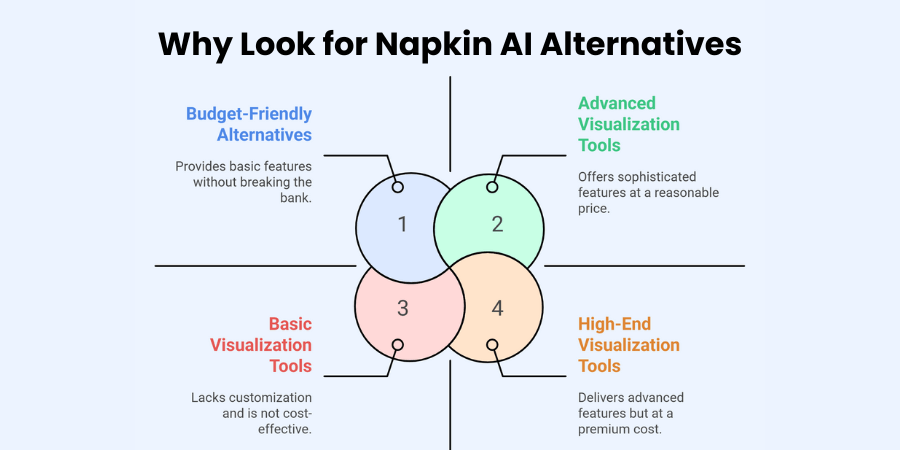
Advanced users often outgrow Napkin AI’s capabilities and require more sophisticated visualization tools for complex projects with specific requirements. The mobile experience of Napkin AI primarily focuses on viewing rather than creating or editing visualizations on portable devices. This limitation affects professionals who need to work on visualizations while traveling or away from their desks. Teams working in regulated industries may require specific security and compliance features not fully addressed by Napkin AI.
Some alternatives offer specialized templates and industry-specific visualization components that Napkin AI does not currently provide to users. Export limitations in the free version, including watermarks, push budget-conscious users toward alternatives with fewer restrictions on final outputs. Organizations with existing design systems may struggle to maintain visual consistency when incorporating Napkin AI outputs into their materials.
The learning curve, while relatively low, still presents challenges for teams seeking immediate implementation without training periods or onboarding time. Alternatives often provide more extensive libraries of icons, shapes, and visual elements for greater creative flexibility and expression.
Top 7 Napkin AI Alternatives
1. Miro AI
Miro AI transforms the collaborative whiteboarding experience with robust AI-powered visualization capabilities for distributed teams across locations. The platform excels at facilitating real-time collaboration with multiple participants simultaneously editing and contributing to visual boards.
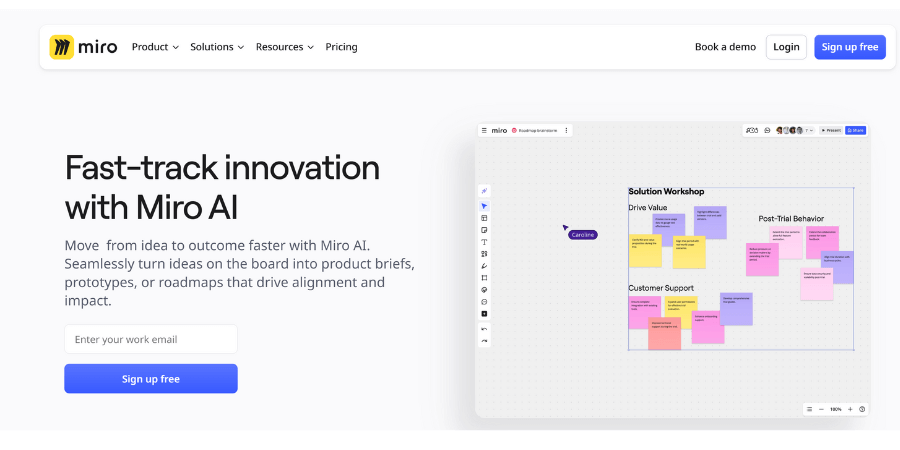
Miro’s extensive template library spans numerous use cases from UX design to agile planning and strategic thinking sessions. The tool integrates seamlessly with over 100 productivity applications including Slack, Microsoft Teams, Asana, and Jira for workflow enhancement.
Miro AI particularly benefits cross-functional teams requiring a central visualization hub with advanced permission controls and organization features. The platform supports unlimited canvas space, allowing teams to create expansive visual landscapes for complex projects and initiatives. Miro’s voting and feedback features facilitate decision-making processes during collaborative sessions with distributed stakeholders.
2. Lucidchart
Lucidchart offers sophisticated diagramming capabilities with AI assistance for creating professional flowcharts, org charts, and technical diagrams. The platform provides enterprise-grade security features and compliance certifications essential for organizations in regulated industries with strict requirements.
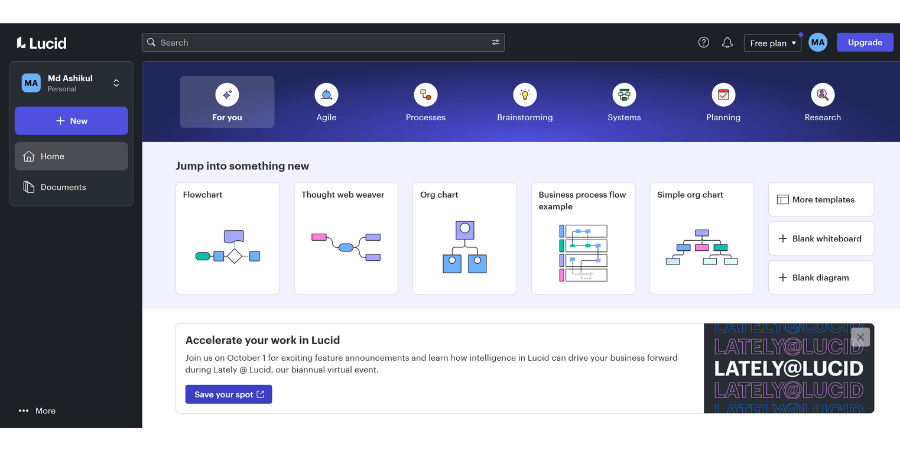
Users appreciate Lucidchart’s extensive shape libraries and precise control over visual elements for technical and process documentation. The tool excels at visualizing complex systems, network architectures, and database schemas with specialized connectors and symbols.
Lucidchart particularly serves technical teams, system architects, and process improvement specialists requiring detailed, accurate visual documentation. The platform’s data linking capabilities allow diagrams to connect with external data sources for dynamic, updated visualizations. Lucidchart offers powerful automation features that can generate diagrams from existing data structures or spreadsheets.
3. Whimsical
Whimsical delivers a lightweight yet powerful experience focused on speed and simplicity for flowcharts, wireframes, and mind maps. The platform features an exceptionally intuitive interface that new users can master within minutes without sacrificing professional-quality outputs.
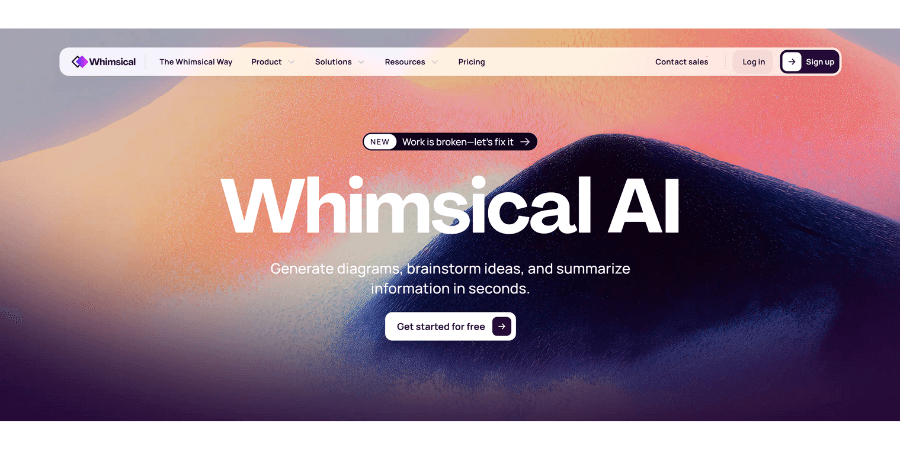
Teams value Whimsical’s clean, modern aesthetic that creates visually appealing diagrams without extensive design knowledge or training. The tool maintains excellent performance even with large, complex diagrams through efficient rendering and optimization techniques.
Whimsical particularly appeals to startups, product teams, and UX designers who prioritize rapid ideation and iteration processes. The platform offers seamless switching between different visualization types within a single board for comprehensive documentation. Whimsical’s sticky notes and text elements support design thinking methodologies and workshop facilitation for teams.
4. Excalidraw
Excalidraw provides a hand-drawn aesthetic for diagrams and sketches that maintains a creative, approachable feel in technical documentation. The platform operates as an open-source tool with strong community support and continuous improvements from contributors worldwide.

Users appreciate Excalidraw’s lightweight nature and ability to run entirely in-browser without requiring installation or account creation. The tool excels at creating diagrams that feel intentionally sketched rather than computer-generated for presentations and documentation.
Excalidraw particularly serves educators, technical writers, and presenters seeking a more human, engaging visual style. The platform supports collaborative editing through shareable links without requiring accounts for participants or viewers. Excalidraw’s library of ready-made components speeds up diagram creation while maintaining the hand-drawn aesthetic consistently.
5. Figma FigJam
FigJam extends Figma’s design ecosystem with collaborative whiteboarding specifically optimized for design teams and stakeholders. The platform seamlessly integrates with Figma design files, creating a smooth workflow from ideation to implementation for design teams.

Users value FigJam’s focus on facilitating design thinking exercises with specialized tools for voting, reactions, and structured feedback. The tool provides excellent performance even with numerous participants and complex boards through optimized rendering technology.
FigJam particularly benefits design teams, product managers, and stakeholders involved in the product development process. The platform’s timer and facilitation tools support structured workshops and time-boxed exercises for efficient meetings. FigJam’s stamp and reaction features encourage participation from all team members, including those less comfortable with drawing.
6. Canva
Canva is a powerful platform that combines AI-powered design assistance with an extensive template library. To get started quickly, check out this comprehensive guide on how to use canva. The site offers millions of stock photos, illustrations, icons, and design elements that help you create polished visuals beyond simple diagrams.
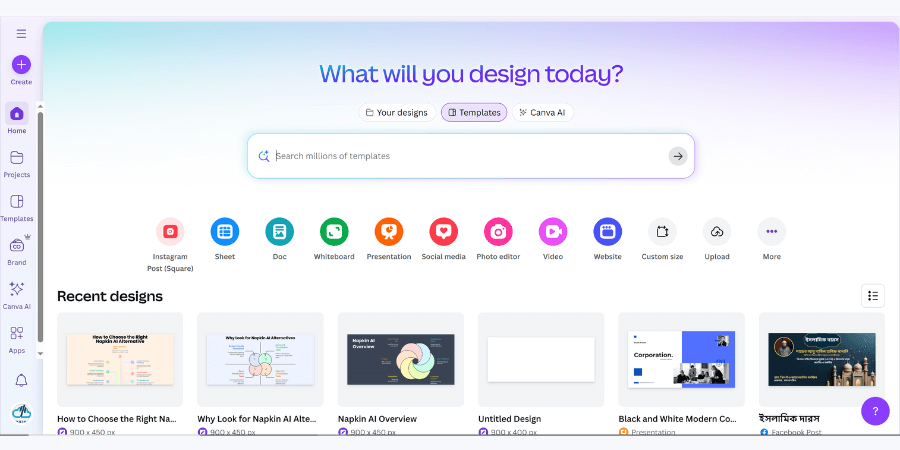
Many users love Canva for producing presentation-ready graphics with minimal effort through easy-to-follow design workflows. It’s ideal for social media graphics, presentations, infographics, and marketing materials. This platform particularly serves marketing teams, content creators, and small businesses without dedicated design resources.
Canva’s brand kit feature helps maintain consistent branding by storing your colors and fonts, while its collaboration tools allow teams to work on projects together efficiently.
7. Notion AI
Notion AI integrates visualization capabilities within a comprehensive workspace that combines notes, databases, and project management tools. The platform unifies text-based content and visual elements in a single connected workspace rather than treating them as separate assets.
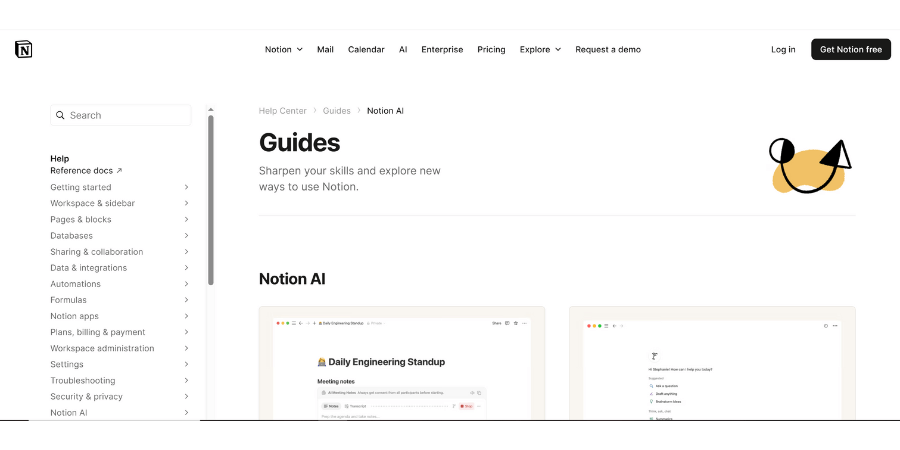
Users value Notion’s ability to embed interactive diagrams directly within contextual documentation and project spaces. The tool excels at creating living documents where visuals evolve alongside written content through collaborative editing processes.
Notion AI particularly benefits teams seeking to reduce tool fragmentation by consolidating documentation and visualization in one platform. The database capabilities allow visual elements to connect with structured data for dynamic, updatable diagrams and charts. Notion’s flexible permission system enables sharing visualizations with varying levels of access for different stakeholders.
Napkin AI vs. Alternatives: Comparison Overview
| Feature | Napkin AI | Miro AI | Lucidchart | Whimsical | Excalidraw | FigJam | Canva | Notion AI |
| Primary Strength | Text-to-visual conversion | Collaborative whiteboarding | Technical diagramming | Rapid flowcharting | Hand-drawn aesthetic | Design collaboration | Visual marketing | Integrated workspace |
| Free Plan | Limited with watermarks | Basic features | Limited objects | 4 boards | Full features | Limited collaborators | Basic features | Limited blocks |
| Mobile Experience | View-only | Full editing | Full editing | Limited editing | Basic support | View with limited editing | Full editing | Full editing |
| Learning Curve | Low | Medium | Medium-High | Very Low | Low | Low | Low | Medium |
| Enterprise Features | Limited | Extensive | Extensive | Moderate | Limited | Extensive | Extensive | Moderate |
| AI Capabilities | Text-to-visual | Content suggestions | Diagram automation | Limited | None | Design suggestions | Design assistance | Content generation |
| Collaboration | Basic | Advanced | Advanced | Good | Basic | Advanced | Good | Advanced |
| Integrations | Limited | Extensive (100+) | Extensive | Moderate | Limited | Design ecosystem | Moderate | Moderate |
| Best For | Quick visualizations | Team collaboration | Technical diagrams | Simple flowcharts | Sketch-like diagrams | Design teams | Marketing visuals | Connected workspaces |
The comparison reveals significant differences in specialized capabilities across these visualization platforms for different user needs. Napkin AI offers the most straightforward text-to-visual conversion but lacks the collaborative depth of alternatives like Miro for team environments. Enterprise features vary dramatically, with Lucidchart and Miro providing the most robust security and administration capabilities for large organizations. Mobile experiences differ substantially, with most alternatives offering better editing capabilities than Napkin AI’s view-only approach for on-the-go work.
Learning curves remain relatively accessible across most platforms, with Whimsical standing out for exceptional ease of use even for beginners. Integration capabilities show considerable variation, potentially affecting workflow efficiency depending on existing tool ecosystems within organizations. Collaboration features demonstrate the greatest disparity, with team-focused tools like Miro and FigJam offering significantly more robust capabilities for group work.
AI implementation varies widely, from Napkin AI’s core text-to-visual functionality to Notion’s broader content generation approach across documents. Pricing structures differ meaningfully across platforms, with varying approaches to free tiers and premium feature distribution for different budget levels.
How to Choose the Right Napkin AI Alternative
Begin by clearly defining your primary use case for visualization tools within your specific workflow and team structure. Consider whether you need primarily diagramming, whiteboarding, presentation creation, or integrated documentation capabilities for your projects.

Evaluate your team size and collaboration requirements, including concurrent editing needs and permission controls for various stakeholders. Assess integration requirements with your existing tools like project management software, communication platforms, and design systems currently used.
Consider budget constraints and evaluate whether free tiers provide sufficient functionality for your core requirements before committing financially. Examine the specific types of visualizations you create most frequently and match them to specialized tools for optimal results.
Technical teams should prioritize precision and specialized shapes available in tools like Lucidchart for system diagrams and documentation. Creative teams might value aesthetic quality and design flexibility found in FigJam or Canva for client-facing materials.
Project managers should consider tools with robust timeline and roadmap visualization capabilities for planning purposes and stakeholder communications. Teams with remote members should prioritize real-time collaboration features and performance with multiple simultaneous editors working concurrently.
Evaluate the learning curve and training requirements against your team’s technical proficiency and available onboarding time for new tools. Consider security requirements, especially for sensitive information visualization in regulated industries or enterprise environments with strict policies.
Assess export capabilities and compatibility with presentation software your organization uses for client or stakeholder communications regularly. Think about scalability as your team grows and visualization needs potentially become more complex or specialized over time. Test multiple tools with realistic use cases rather than relying solely on feature comparisons or marketing materials from providers.
Consider creating a weighted decision matrix that scores each alternative against your specific requirements for objective comparison. Remember that different teams within your organization might benefit from different visualization tools based on their specific needs and workflows.
Conclusion
The landscape of Napkin AI alternatives offers diverse options for different visualization needs. Miro excels for collaboration, Lucidchart for technical diagrams, Whimsical for simplicity, Excalidraw for aesthetics, FigJam for design workflows, Canva for visual creation, and Notion AI for connected workspaces.
The ideal choice depends on your requirements, team structure, and technology ecosystem. Consider starting with free tiers before committing to paid plans. Prioritize tools that solve your core pain points and integrate smoothly. The right Napkin AI alternative should enhance productivity without adding complexity.
Frequently Asked Questions
What is the best free alternative to Napkin AI?
Excalidraw offers the most comprehensive free alternative with no watermarks and full functionality without subscription requirements for users. The open-source platform provides complete access to all features without the limitations typically found in freemium models. Other notable free options include limited tiers of Whimsical and Canva with some feature restrictions but still providing core functionality.
Can Napkin AI alternatives handle complex technical diagrams?
Lucidchart specifically excels at complex technical diagrams with specialized shapes and connectors for system architecture, network diagrams, and database modeling. The platform provides precise control over technical elements and relationships between components for professional documentation. Miro also offers robust technical diagramming capabilities with additional collaborative features for team input and feedback.
Which Napkin AI alternative has the best collaboration features?
Miro provides the most comprehensive collaboration capabilities with real-time editing, cursor tracking, commenting, voting, and presentation modes for teams. The platform supports unlimited collaborators on paid plans with sophisticated permission controls and team management features. FigJam offers similar strengths specifically optimized for design team collaboration workflows with specialized feedback mechanisms.
Do any Napkin AI alternatives work entirely offline?
Excalidraw offers a progressive web application that can function offline after initial loading for users without constant connectivity. The tool allows saving files locally without requiring cloud connectivity for basic functionality and diagram creation. Most other alternatives require internet connectivity for core features and cloud-based storage of diagrams and visual assets.
Which alternative integrates best with existing productivity tools?
Miro offers the most extensive integration ecosystem with over 100 connections to popular productivity tools across organizations. The platform connects with Slack, Microsoft Teams, Google Workspace, Asana, Jira, and numerous other platforms seamlessly. Notion also provides strong integration capabilities within its workspace environment through APIs and embedded content support for connected workflows.
Shaif Azad
Related Post
Top 10 AI Development Companies in New Jersey for Business
Are you searching for the perfect AI development partner in New Jersey? Have you wondered which...
Top 10 AI Development Companies in New Hampshire
Are you watching New Hampshire’s tech landscape transform before your eyes? Your state is quietly becoming...
Top AI Companies in Nebraska Every Business Should Know
Are you a Nebraska business owner wondering how artificial intelligence could transform your operations? Picture this...



